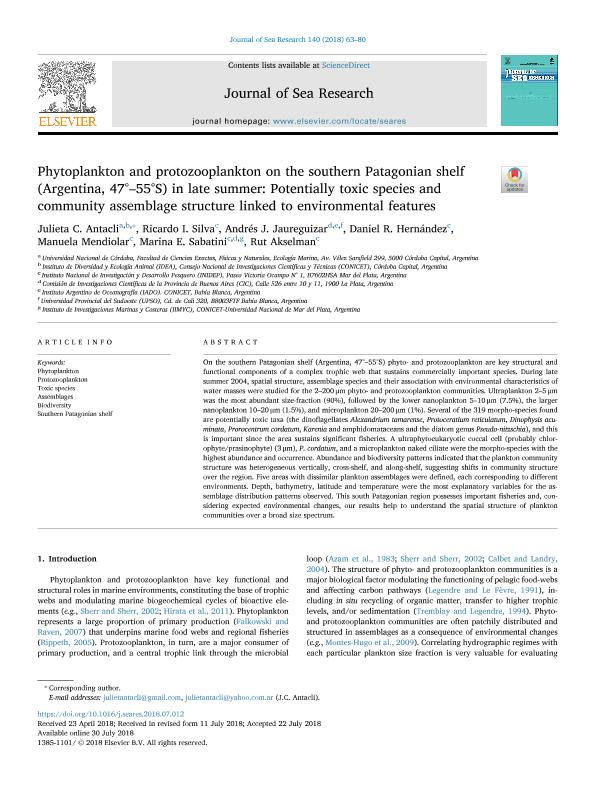Artículo
Phytoplankton and protozooplankton on the southern Patagonian shelf (Argentina, 47°–55°S) in late summer: Potentially toxic species and community assemblage structure linked to environmental features
Antacli, Julieta Carolina ; Silva, Ricardo L; Jaureguizar, Andrés Javier
; Silva, Ricardo L; Jaureguizar, Andrés Javier ; Hernández, Daniel R; Mendiolar, Manuela; Sabatini, Marina Elena
; Hernández, Daniel R; Mendiolar, Manuela; Sabatini, Marina Elena ; Akselman, Rut
; Akselman, Rut
 ; Silva, Ricardo L; Jaureguizar, Andrés Javier
; Silva, Ricardo L; Jaureguizar, Andrés Javier ; Hernández, Daniel R; Mendiolar, Manuela; Sabatini, Marina Elena
; Hernández, Daniel R; Mendiolar, Manuela; Sabatini, Marina Elena ; Akselman, Rut
; Akselman, Rut
Fecha de publicación:
10/2018
Editorial:
Elsevier Science
Revista:
Journal of Sea Research
ISSN:
1385-1101
Idioma:
Inglés
Tipo de recurso:
Artículo publicado
Clasificación temática:
Resumen
On the southern Patagonian shelf (Argentina, 47°–55°S) phyto- and protozooplankton are key structural and functional components of a complex trophic web that sustains commercially important species. During late summer 2004, spatial structure, assemblage species and their association with environmental characteristics of water masses were studied for the 2–200 μm phyto- and protozooplankton communities. Ultraplankton 2–5 μm was the most abundant size-fraction (90%), followed by the lower nanoplankton 5–10 μm (7.5%), the larger nanoplankton 10–20 μm (1.5%), and microplankton 20–200 μm (1%). Several of the 319 morpho-species found are potentially toxic taxa (the dinoflagellates Alexandrium tamarense, Protoceratium reticulatum, Dinophysis acuminata, Prorocentrum cordatum, Karenia and amphidomataceans and the diatom genus Pseudo-nitzschia), and this is important since the area sustains significant fisheries. A ultraphytoeukaryotic coccal cell (probably chlorophyte/prasinophyte) (3 μm), P. cordatum, and a microplankton naked ciliate were the morpho-species with the highest abundance and occurrence. Abundance and biodiversity patterns indicated that the plankton community structure was heterogeneous vertically, cross-shelf, and along-shelf, suggesting shifts in community structure over the region. Five areas with dissimilar plankton assemblages were defined, each corresponding to different environments. Depth, bathymetry, latitude and temperature were the most explanatory variables for the assemblage distribution patterns observed. This south Patagonian region possesses important fisheries and, considering expected environmental changes, our results help to understand the spatial structure of plankton communities over a broad size spectrum.
Archivos asociados
Licencia
Identificadores
Colecciones
Articulos(IDEA)
Articulos de INSTITUTO DE DIVERSIDAD Y ECOLOGIA ANIMAL
Articulos de INSTITUTO DE DIVERSIDAD Y ECOLOGIA ANIMAL
Citación
Antacli, Julieta Carolina; Silva, Ricardo L; Jaureguizar, Andrés Javier; Hernández, Daniel R; Mendiolar, Manuela; et al.; Phytoplankton and protozooplankton on the southern Patagonian shelf (Argentina, 47°–55°S) in late summer: Potentially toxic species and community assemblage structure linked to environmental features; Elsevier Science; Journal of Sea Research; 140; 10-2018; 63-80
Compartir
Altmétricas



